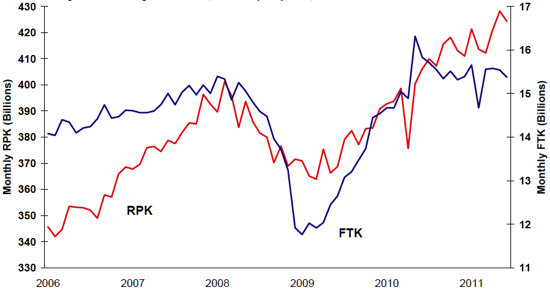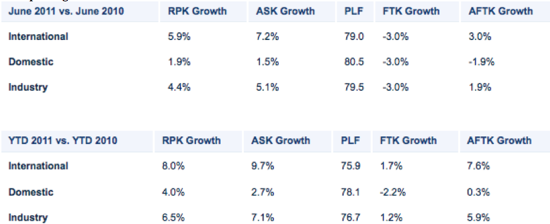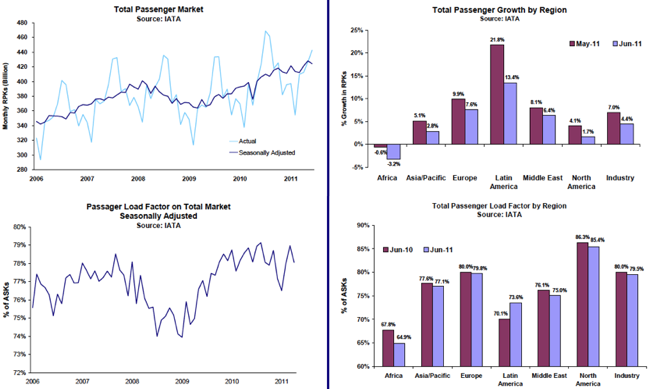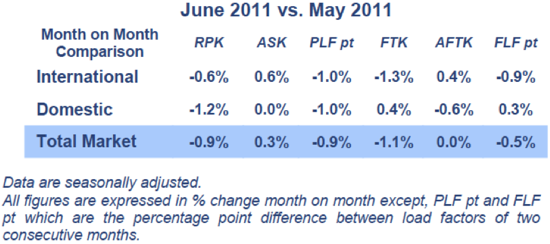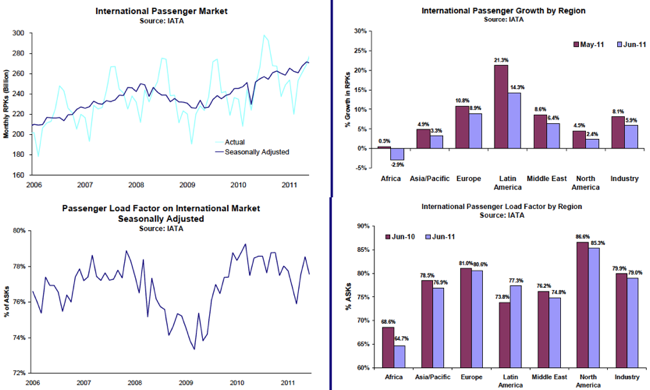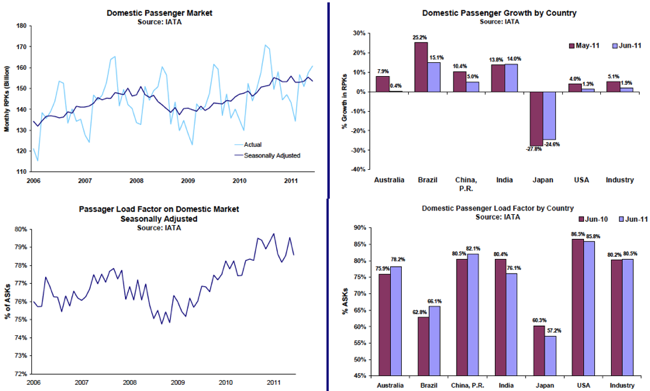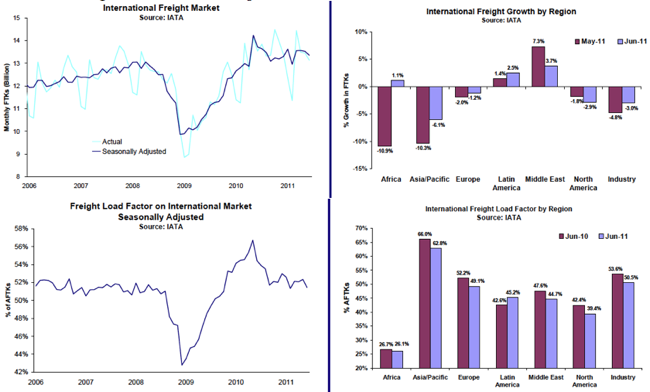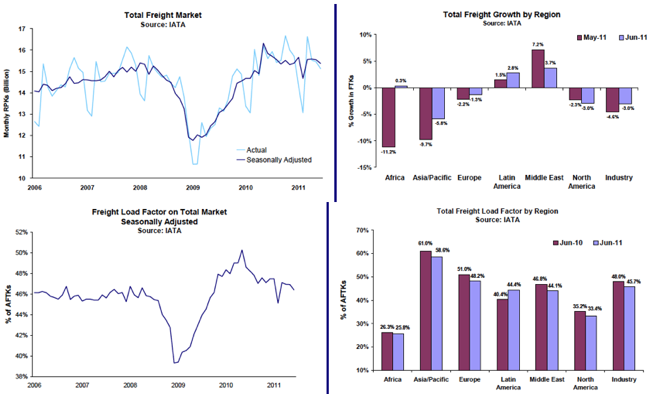IATA notes speed bump in a gradual post recession traffic improvement
Air traffic growth softened in Jun-2011, under pressure from rising jet fuel prices and higher tax rates in some countries. However, the trend for passenger travel remains upwards, but at a slower pace than the post recession rebound, which was at an annual rate close to 10%, IATA noted.
Total Air Freight and Passenger Volumes (Seasonally Adjusted)
The softening in demand in Jun-2011 follows two months of improving traffic volumes. Passenger demand increased 4.4% in Jun-2011 while freight demand was 3% weaker in the month (freight volumes have not grown since Jul/Aug-2010). Meanwhile, load factors weakened, as capacity grew at a faster pace than traffic growth in Jun-2011, causing a fall in load factors. However, this is a good level of seat utilization by historic standards but nonetheless is worse than it was last month, and is lower than the peak in 2010, IATA noted.
IATA passenger traffic: Jun-2011
Despite the slowing growth, the trend in air travel remains upwards. After stripping out the many shocks as well as the seasonality affecting air travel demand, the current pace of growth in the trend is estimated to be 4-5% p/a, according to IATA. However, the trend is below the 20-year average of 6% and is around half the pace of the post-recession expansion between early 2009 and early 2010. This slowdown reflects slower economic growth and the higher cost of travel, due to the rise in jet kerosene prices and, in some countries, higher taxes on passengers.
Total market (domestic and international) traffic developments
Compared to May-2011, both passenger and cargo markets contracted by about 1%, with load factors also weakening. "For passenger traffic, this is a speed-bump in a gradual post recession improvement. But air cargo continues in the doldrums at 6% below the post-recession peak," said Tony Tyler, IATA's Director General and CEO. Mr Tyler also noted that the "industry is living in several different realities. With high load factors and an upward growth trend, the passenger business is doing better than cargo."
Jun-2011 vs May-2011 traffic
International market stronger than domestic markets
Meanwhile, the international travel market continues to be stronger than the stronger than domestic markets, which has seen no growth on average since 3Q2011.
International passenger market traffic developments
The stagnating domestic growth is partly due to the maturity of the US domestic market, which represents more than 50% of all domestic air travel. It is also due to the sluggishness of the recovery in Japan's domestic market, which remains 23% smaller than pre-crisis levels. However, other domestic air travel markets in the BRIC economies are strong.
Load factors on domestic air travel markets peaked later than those on international markets. The fall during the recession was also smaller on domestic than on international markets, since the collapse in international trade was more substantial than the fall of domestic economic activity. The subsequent improvement in load factors has taken longer on domestic markets, peaking in 3Q2011. Since then there has been some moderate slippage. Meanwhile, load factors on Chinese and Indian domestic markets are now comparable to the performance of airlines on developed country markets.
For India in particular this is a very sharp improvement over the situation just two to three years ago when severe excess capacity was causing a lot of problems for airline profitability. Brazil's load factor is relatively low by comparison, but has also improved substantially from very low levels of seat utilization a few years earlier. Japan's low load factor reflects the sluggishness of the recovery from the 11 March shock.
Domestic passenger market traffic developments
Regional growth patterns shifting
Meanwhile, regional growth patterns are shifting, with IATA noting that the Middle East carriers have moderated to a single digit expansion and tighter economic conditions have slowed China's growth. Meanwhile, Latin America is leading the industry expansion, boosted by strong economic growth and tradef flows, followed by Europe which is growing strongly despite its currency crisis, with many European airlines are benefiting from the trade and business travel generated by the weak Euro. North America, meanwhile, is underperforming the industry on growth but leading on load factors.
IATA noted that the Japanese domestic market is only recovering slowly from the impact of the 11-Mar-2011 earthquake and tsunami, with RPKs still 23% down on Feb-2011 levels. The recovery of international travel to the North African markets hit by civil unrest has been a little faster but even these markets are still down, at some 4% below Jan-2011.
Traffic by regional markets: Jun-2011
|
Region |
International passenger markets |
Domestic passenger markets |
Freight markets (domestic and international) |
|---|---|---|---|
|
Continue to experience the weakest demand with a 2.9% fall compared to Jun-2010 levels. The continued political unrest in North Africa is the primary driver of the poor performance which is also reflected in load factors which stood at 64.7%, which is 3.9 ppts below the previous year's levels. |
|||
|
Asia-Pacific |
Saw demand grow by 3.3%. Demand growth was held at about half the global average due to tightening economic policies and the effects of the earthquake and tsunami in Japan. The weakness in Japan's international market has knocked 0.5% oots off the region's growth. Asia Pacific carriers recorded a load factor of 76.9% which is 2.1 ppts below the global average. |
Demand in the Japanese domestic market continues to suffer from the effects of March's tsunami and earthquake, recording a 24.6% fall compared to the previous year's performance. This is a slow improvement on the -27.8% recorded for May-2011. India was the second fastest growing domestic market with growth of 14.0%. While China's 5.0% growth is also impressive, it is a step change from the 14.6% recorded in 2010 and the 10.4% recorded in May. China, the world's second largest domestic market, still has enormous potential. As with China's international markets, the slowdown reflects a squeeze on consumer spending power by tighter economic policies. |
The biggest players in the air freight market with a 40.5% market share, also recorded the largest year-on-year decline (-5.8%). This is mainly attributable to (1) disrupted supply chains for the electronics and auto industries in the wake of the Japanese tsunami and earthquake and (2) slower economic growth in China. The strength of the region however is shown in the maintenance of the highest load factors (58.6%) well ahead of the 45.7% industry average for the month. |
|
Showing the second most robust expansion of demand with 8.9% growth compared to Jun-2010. The weak euro is supporting a strong inbound travel trend and business travel associated with growing exports. Load factors for the region stood at 80.6%, the second highest among regions. |
Posted a 1.3% decline and North American carriers recorded a decline of 3.0% compared to June 2010 levels. |
||
|
Experienced the highest growth levels with a 14.3% increase over Jun-2010. Disruptions following Chile's Puyehue Volcano eruption contributed to a drop from the 21.3% increase recorded in May-2011. Load factors for the region rose to 77.3% (from 73.8% in Jun-2010) which will help the region's carriers deal with higher fuel costs. |
Brazil led domestic growth with a 15.1% demand expansion over the previous year, propelled by strong growth in household incomes. |
||
|
Recorded a 6.4% increase in demand against a capacity increase of 8.4% for a load factor of 74.8%. For the second consecutive month both demand and capacity increases by Middle East carriers have fallen behind those of Europe and Latin America. |
|||
|
Saw May-2011's 4.5% demand growth fall to 2.4%. With tight capacity discipline, airlines there delivered a load factor of 85.3%,the highest among the regions. |
The US, which represents more than 50% of domestic travel, posted 1.3% growth in Jun-2011. |
Freight trend "looks little better than flat"
IATA noted that the trend in air freight is harder to discern but, after the Jun-2011 data, "now looks little better than flat". International markets are seeing a stronger demand than domestic markets, although even domestic growth is very subdued. World trade in goods continues to expand but other modes of transport are benefiting from this growth, not air, IATA said.
International freight market traffic developments
The size of the international air freight market is a little better than the middle of last year and is stronger than domestic air freight but remains 6% smaller than the level reached in May-2010.
Most regions, including the overall total, are now experiencing air freight volumes lower than they were carrying last year. In June-2011, the weakest region was Asia-Pacific, partly due to Japan, since it is a key supplier in the electronics and autos supply chains.
The supply-demand situation has deteriorated further in the past year in the air freight business than it has for the passenger business, which will be a further challenge to the profitability of airlines with a significant freight business.
Meanwhile, load factors on domestic markets are generally half that achieved on international markets, so the overall freight load factor for commercial airlines in Jun-2011 was 45.7%, compared to 50.5% on international markets alone. With significant new capacity due to arrive later this year it may prove challenging to sustain even these levels of freight capacity utilization, IATA cautioned.
Total freight market traffic developments
The bottom line
IATA reiterated that it is forecasting an industry profit of USD4 billion for 2011 which is a 78% fall from the USD18 billion that the airlines made in 2010. On anticipated revenues of USD598 billion, this translates to a net industry margin of 0.7%. Based on a forecast average oil price of USD110/barrel for 2011 and a jet fuel price of USD126.5/barrel, the industry fuel bill is expected to be USD176 billion which accounts for 30% of costs.
"What is clear is that the rising jet fuel price is putting pressure on the bottom line. The average price for the second quarter was USD133/barrel which is an increase of USD10 over the first quarter. With an expected profit margin of only 0.7%, the ability of airlines to recoup this cost is critical to staying in the black for the year. Slower economic growth makes these challenges all the more difficult. It is certainly not the time to burden the industry with increases in other costs, including taxation," Mr Tyler said.
IATA also stated that as airlines start publishing 2Q2011 result would reflect better passenger market conditions than in the first quarter. On average passenger traffic strengthened and load factors rose during the quarter while freight markets saw less of a rise in volumes and little improvement in load factors. Moreover, jet kerosene prices increased by more than USD10 a barrel between quarters, to average USD133/b in the second quarter. The very different experience for airlines, between geographical markets and between passenger and freight markets, will be a significant influence on whether they have been able to recover the rise in fuel costs, IATA added.
